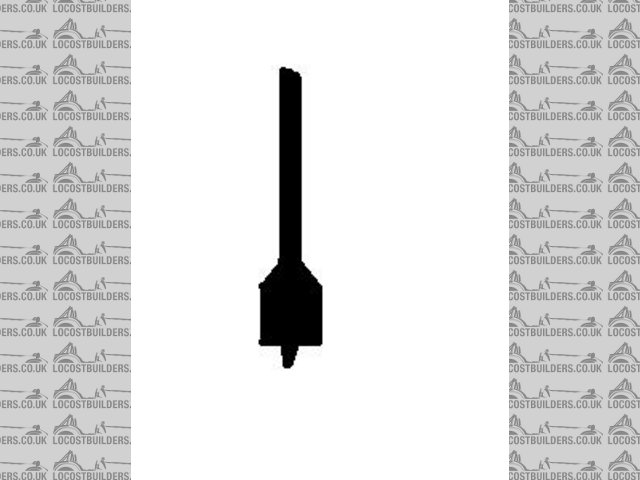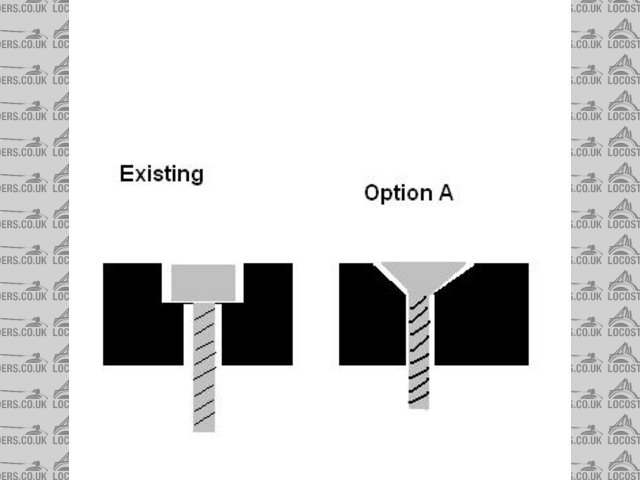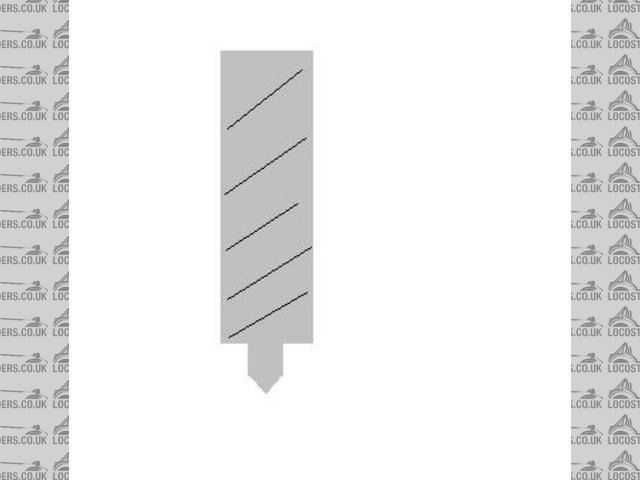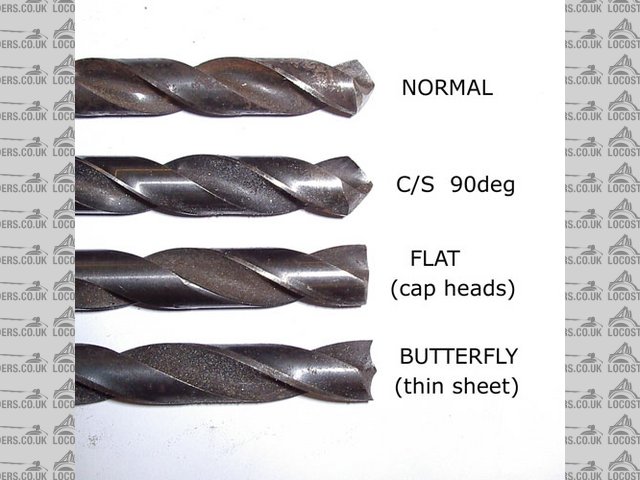
What is a Flat Drill
ditchlewis - 12/9/07 at 07:49 AM
I have to re drill the base of my starter motor. it is retained with a allen headed bolt that is flush with the face of the base.
the man at cambridge motorsport said i needed a flat head drill. what is one of these?
i know that i have to drill a hole for the bolt but then i have to ream out the base to get the bolt to sit flush with the face.
is a flat head drill bit one of these?
Ditch





Rescued attachment flat drill.JPG
Hurdsey - 12/9/07 at 07:58 AM
Nope thats a Flat Bit for wood.
I'm not an engineer but I think a flat head drill is designed to drill holes with a flat bottom instead of a bevelled bottom iyswim. I'm
sure a good Engineers merchants would stock them.
It may be reffered to as a Reamer but I'm not sure.
Mark Allanson - 12/9/07 at 07:59 AM
..or perhaps an end mill
designer - 12/9/07 at 08:00 AM
The drill you showed is for wood.
A flat drill the bloke is talking about is one used when the hole does not go through the piece being drilled and it leaves a flat bottom to the
hole.
Where are you drilling on the base? Are you just making another mounting hole?
JAG - 12/9/07 at 08:02 AM
It's not referred to as a Reamer.
But it is a drill designed to cut a flat bottomed hole.
Be very careful when using it - the shorter cutting edge (than a normal drill) means they need a lot of torque to drive them and can only cut
relatively slowly 
Fred W B - 12/9/07 at 08:16 AM
Its called a spot face tool.
If you can't find one can you change to a bolt with a countersunk head, as a chamfer tool is easier to find?
Cheers
Fred W B
[Edited on 12/9/07 by Fred W B]
ditchlewis - 12/9/07 at 08:31 AM
many thanks lads







the alloy mounting plate on my starter motor needs moving round. the existing holes have a flat bottom to them to seat the bolt flat and flush to the
face.
Fred's idea sounds good.
the question i now have is in a high torque application is option A (see below) more likley to fail than the existing option?
ditch



[Edited on 12/9/07 by ditchlewis]
ditchlewis - 12/9/07 at 08:32 AM
here is the pick
Ditch






Rescued attachment options.JPG
02GF74 - 12/9/07 at 09:06 AM
quite possibly but not that you would ever achieve it.
basically, and I could be wrong, the weakest part of the bolt is the thinest part i.e. the threaded section - that would where it would fail so the
shape fo the bolt head does not matter.
Mr Rob - 12/9/07 at 10:11 AM
If you have a bench grinder you can grind a normal drill bit flat. Drill the hole first with a normal drill an then go in with your new ground bit....
job done.
ditchlewis - 12/9/07 at 11:08 AM
just remembered that i bought some bits very early on in my build that may do the job.
i will have to look and measure what i have.
i will have to drill a hole for the bolt first then i will have to use these bits (see below).




 . these bits have a flat face on them.
. these bits have a flat face on them.
Ditch





Rescued attachment bit.JPG
iank - 12/9/07 at 12:04 PM
That looks like a lip and spur drill (flat with a spike) I think they are just for wood (also called a dowel bit IIRC).
tks - 12/9/07 at 12:45 PM
quote:
Originally posted by Mr Rob
If you have a bench grinder you can grind a normal drill bit flat. Drill the hole first with a normal drill an then go in with your new ground bit....
job done.
i wouold try this idea, because with a flat drill its not easy to pick the right place of drilling, saying that, when you cut down a normal drill, you
don't leave a cutting edge.
i would go for the countersunk screws.
timf - 12/9/07 at 01:07 PM
you need something like this
http://www.screwfix.com/search.do;jsessionid=A0P1YSBZSQFOYCSTHZPCFFI?_dyncharset=UTF-8&fh_search=counterbore
or from ebay
http://stores.ebay.co.uk/Mattools_CUTTING-TOOLS_Countersinks-Counterbores_W0QQcolZ4QQdirZ1QQfsubZ3277677QQftidZ2QQtZkm
looks like

[Edited on 12/9/07 by timf]
ditchlewis - 12/9/07 at 01:28 PM
iank
the above drill was for steel and was titanium, it went through steel like butter








 .
.
problemis that i have used them all alot and they are probably blunt now


 and they were about a ten to fifteen quid each.
and they were about a ten to fifteen quid each. 



ditch



02GF74 - 12/9/07 at 01:43 PM
when I had to do something like this i.e. fltten out hte bottom of a blind drilled hole, I used end mills.
mmart do a set from 4 to 10 mm.
Alan B - 12/9/07 at 02:08 PM
As Timf shows the correct tool is called a counterbore......a spotface is essentially a shallow counterbore used on castings or rough surfacee to give
a true seating face.
They can be bought in sets with interchangeable pilots or individually.
907 - 12/9/07 at 04:02 PM
Mr Rob has the locost option.
In with a normal drill to below the surface, then take out the angle with a flat one.
A drill is a drill. How you just sharpen it depends on what you want to do.
Hth
Paul G


Rescued attachment drills-tx-s.jpg
NS Dev - 13/9/07 at 05:46 PM
as Mr Rob and 907 said, just grind a std drill bit flat at the end.
I have used this to do spot facing many times, as spot face cutters are very expensive!!
MikeRJ - 20/9/07 at 09:43 PM
quote:
Originally posted by iank
That looks like a lip and spur drill (flat with a spike) I think they are just for wood (also called a dowel bit IIRC).
But they do work on metal with a bit of modification! My spot weld cutter fell to pieces during a job some time back and I modified one of these wood
bits to make the spike shorter and it ripped through dozens spot welds with little problem. It was a reasonably quality drill bit though, not a
cheapy.
iank - 21/9/07 at 09:35 AM
Using them as a spot weld cutter would be fine I'd image, but they bind if you try and drill thick metal due to the cutting geometry.
http://en.wikipedia.org/wiki/Drill_bit
The one's I've got scream into wood with the lightest pressure, they actually seem to tunnel into the hole on their own.
Vindi_andy - 21/9/07 at 12:25 PM
when we had to use flat ended drills at college during my apprenticeship(many moons ago) we always had to drill the hole with a standard drill first
then just flatten the bottom of the hole with the flat drill
Part of the problem I experienced was as someone else said earlier about the centreing also if you dont have a pre drilled hole the bit has a tendecy
to wander









